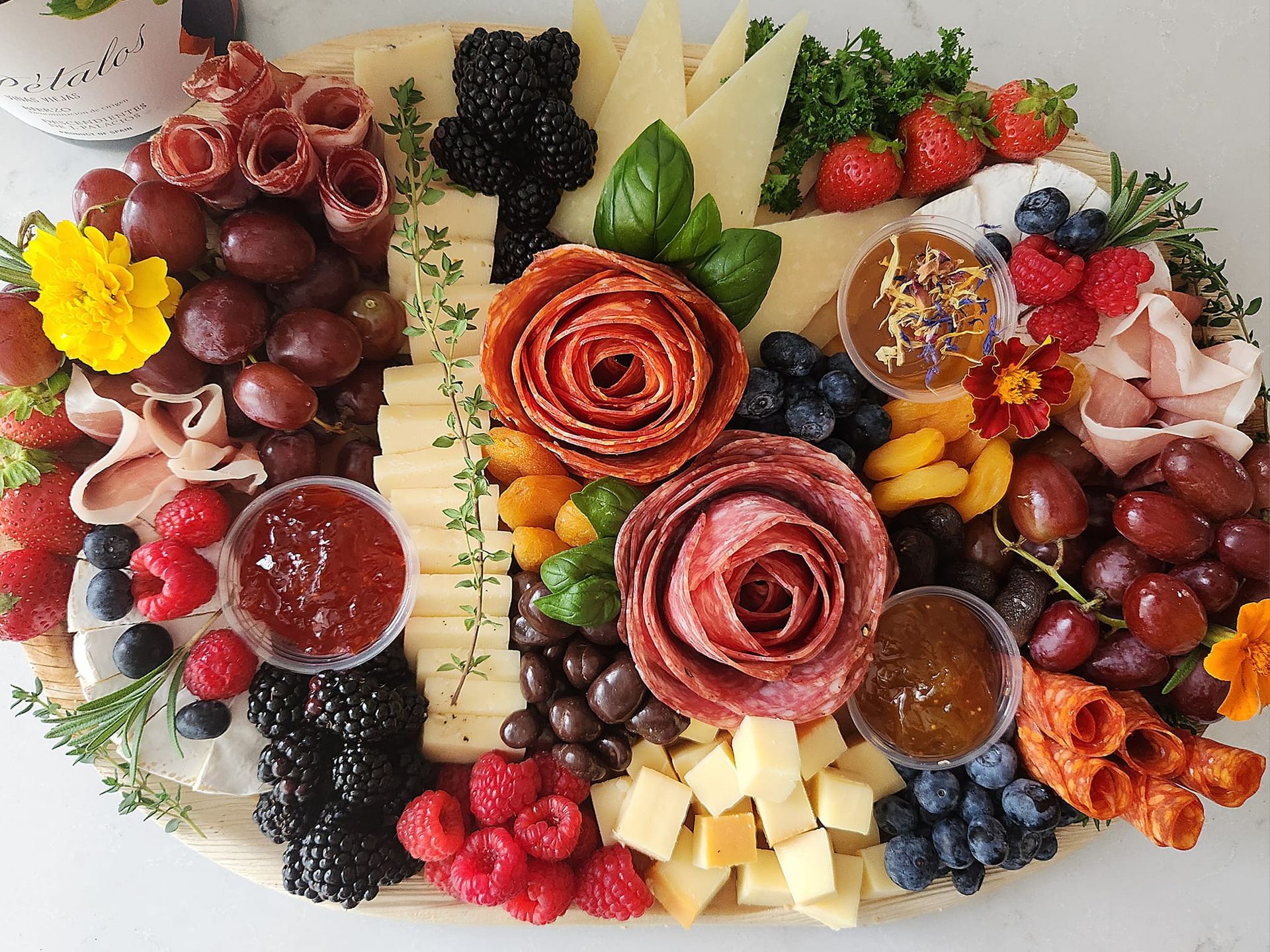Charcuterie boards are a crowd favorite, offering an assortment of flavors and textures that appeal to almost everyone. However, when food allergies enter the equation, what seems like a fun and easy spread can become a tricky puzzle. How do you create a charcuterie board that everyone can enjoy, regardless of their dietary needs? The team behind Let It Be Charcuterie, a Canadian business specializing in allergen-safe charcuterie, is setting a new standard by offering delicious, safe options for those with food allergies and intolerances.
I saw Let It Be's Facebook post and loved how she used her family's experience to make food safer for others.

So, let's create a beautiful, allergen-friendly charcuterie board that keeps everyone safe without compromising on taste. We’ll also highlight Let It Be Charcuterie’s inspiring story, which showcases the importance of food allergy awareness in today’s food culture.
The Reality of Food Allergies Today
Food allergies are no longer a rare occurrence at gatherings. In fact, they are becoming more common than ever before. According to statistics shared by Let It Be Charcuterie, 8% of Canadians have at least one food allergy, while 20-25% of Canadians experience some form of food intolerance. Furthermore, up to 30% of Canadians report dealing with food sensitivities. These figures are a clear reminder of the need for inclusive options when it comes to food.
It’s easy to overlook these numbers when planning a charcuterie board. You may think, “A little cheese and crackers, maybe some nuts and fruit—how hard can it be?” But for someone with severe allergies to ingredients like dairy, gluten, nuts, or eggs, a traditional charcuterie board could turn into a health hazard. That’s where businesses like Let It Be Charcuterie come in.
Let It Be Charcuterie: A Family-Driven Mission
Let It Be Charcuterie, based in Burlington, Ontario, is a prime example of a business that understands the complexities of food allergies on a personal level. In a recent Facebook post, the owner shared their family’s story of navigating multiple food allergies daily. One of their children is allergic to eggs, while another has a broader spectrum of allergies, including peanuts, tree nuts, soy, sunflower seeds, and sesame. Additionally, their eldest battles Eosinophilic Esophagitis (EOE), a condition that requires a gluten-free and dairy-free diet to manage.
The owner has spent over a decade reading food labels, contacting manufacturers, and learning how to safely feed their family. Now, they use that expertise to help others enjoy food without fear. At Let It Be Charcuterie, they offer custom charcuterie boards that cater to various dietary restrictions, ensuring that everyone at the table has something safe and delicious to enjoy.
This personal mission and hands-on experience make Let It Be Charcuterie a trusted name for anyone looking for allergen-free charcuterie options. Their approach goes beyond business; it’s about ensuring that no one feels left out or anxious about the food they eat.
Building an Allergy-Friendly Charcuterie Board
Inspired by Let It Be Charcuterie’s thoughtful approach, here’s how you can create your own allergen-friendly charcuterie board, whether you’re hosting an intimate gathering or a larger event.
1. Choose Allergen-Free Ingredients
The first step in building an allergy-friendly charcuterie board is knowing what ingredients are safe for everyone. Here’s a breakdown of common allergens and how you can substitute them:
- Dairy-Free Cheeses: Traditional charcuterie boards often feature a variety of cheeses, but dairy is a no-go for many people. Opt for dairy-free cheeses made from coconut, almond, or cashews. There are plenty of options on the market that offer the same rich, creamy texture as traditional cheese.
- Nut-Free Options: Nuts are a staple in many charcuterie spreads, but they pose a serious risk for those with peanut or tree nut allergies. Swap nuts for roasted seeds (like pumpkin or sunflower), or include allergen-free nut butter alternatives such as SunButter or tahini.
- Gluten-Free Crackers: For those with celiac disease or gluten sensitivities, gluten-free crackers are a must. Luckily, there are many brands that offer gluten-free options made from rice, quinoa, or corn.
- Egg-Free Spreads: If you’re offering dips or spreads, make sure they’re egg-free. Hummus, guacamole, and dairy-free pestos are great options that are naturally egg-free.
2. Prevent Cross-Contamination
Even with the right ingredients, cross-contamination is a real concern. Here are some tips to keep your charcuterie board safe:
- Separate Serving Utensils: Use different utensils for each section of your board, especially if you’re offering both allergen-free and traditional items.
- Clearly Label Allergen-Free Zones: If your board has separate sections for allergen-free and regular items, make sure it’s clear which is which. Small flags or signs can help your guests identify which foods are safe for them.
- Prep Separately: If possible, prepare allergen-free foods on a separate surface from traditional items. For example, if you’re slicing cheese, use a different knife and cutting board for dairy-free options.
3. Offer a Variety of Safe Proteins
Charcuterie boards are often associated with cured meats, but not all of them are allergy-friendly. Many cured meats contain allergens like soy, gluten, or dairy, which can cause issues for people with food sensitivities. Opt for clean-label meats or offer plant-based protein alternatives like marinated tofu, tempeh, or vegan deli slices. These options provide protein without the risk of triggering an allergic reaction.
4. Incorporate Fresh Fruits and Vegetables
Fruits and veggies are naturally allergen-friendly and make a great addition to any charcuterie board. Think colorful options like grapes, apple slices, cucumber rounds, and carrot sticks. Not only do they add a pop of color, but they also provide freshness and crunch to balance out the richness of other ingredients.
5. Communicate with Guests
If you’re hosting, one of the best ways to ensure everyone can enjoy your charcuterie board is to ask about any dietary restrictions ahead of time. A simple message to guests asking about allergies or intolerances can help you plan accordingly. By showing that you’re aware and considerate of their needs, you’ll make your guests feel more comfortable.

The Future of Charcuterie: Inclusivity and Awareness
As food allergies become more prevalent, there’s a growing demand for businesses like Let It Be Charcuterie that put inclusivity and safety first. Offering allergen-friendly options is no longer just a “nice-to-have” feature—it’s essential for creating a welcoming and inclusive food experience.
Let It Be Charcuterie’s dedication to providing safe and delicious charcuterie for those with food allergies and intolerances is both inspiring and necessary. Their approach sets a high standard for others in the food industry, proving that with a little creativity and care, it’s possible to offer something for everyone at the table.
Creating an allergy-friendly charcuterie board is more than just a trend; it’s a reflection of a growing awareness around food sensitivities and the need to make every dining experience inclusive. With inspiration from businesses like Let It Be Charcuterie, it’s clear that safe and delicious charcuterie boards are within reach for everyone, regardless of dietary needs. By taking a little extra time to choose the right ingredients, prevent cross-contamination, and communicate with guests, you can create a spread that’s not only beautiful but safe and enjoyable for all.
Want to discuss your allergy policy? We're here to help -
elisa@charcuteriecity.com.
Charcuterie Calculator
Still trying to nail down your pricing? We can help! Check out our interactive Charcuterie Calculator that allows you to figure out your cost per serving.
Contact Us
The Rundown
Our Newsletter
We will get back to you as soon as possible.
Please try again later.
Subscribe For Our Newsletter
All Rights Reserved | Powered By Charcuterie Marketing Crew

